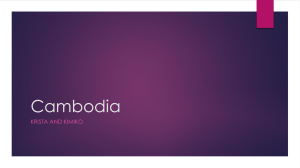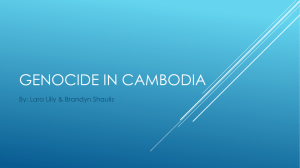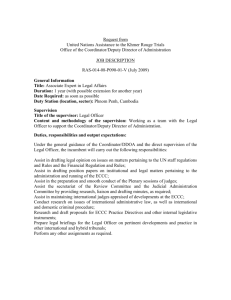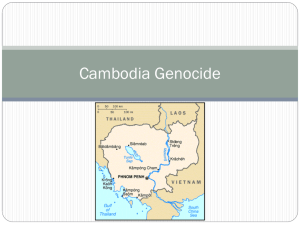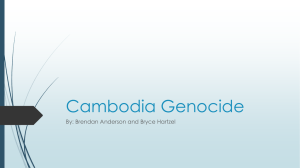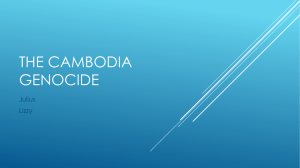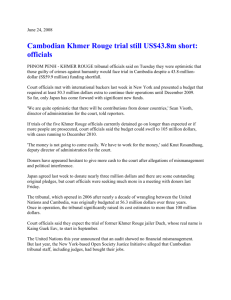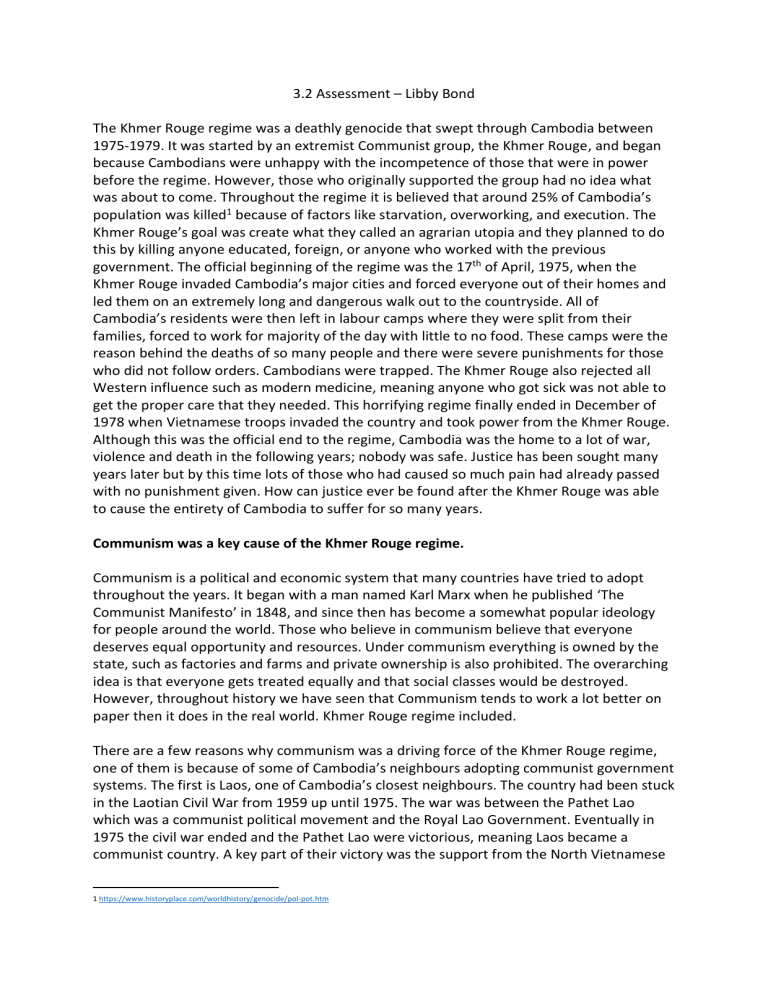
3.2 Assessment – Libby Bond The Khmer Rouge regime was a deathly genocide that swept through Cambodia between 1975-1979. It was started by an extremist Communist group, the Khmer Rouge, and began because Cambodians were unhappy with the incompetence of those that were in power before the regime. However, those who originally supported the group had no idea what was about to come. Throughout the regime it is believed that around 25% of Cambodia’s population was killed1 because of factors like starvation, overworking, and execution. The Khmer Rouge’s goal was create what they called an agrarian utopia and they planned to do this by killing anyone educated, foreign, or anyone who worked with the previous government. The official beginning of the regime was the 17th of April, 1975, when the Khmer Rouge invaded Cambodia’s major cities and forced everyone out of their homes and led them on an extremely long and dangerous walk out to the countryside. All of Cambodia’s residents were then left in labour camps where they were split from their families, forced to work for majority of the day with little to no food. These camps were the reason behind the deaths of so many people and there were severe punishments for those who did not follow orders. Cambodians were trapped. The Khmer Rouge also rejected all Western influence such as modern medicine, meaning anyone who got sick was not able to get the proper care that they needed. This horrifying regime finally ended in December of 1978 when Vietnamese troops invaded the country and took power from the Khmer Rouge. Although this was the official end to the regime, Cambodia was the home to a lot of war, violence and death in the following years; nobody was safe. Justice has been sought many years later but by this time lots of those who had caused so much pain had already passed with no punishment given. How can justice ever be found after the Khmer Rouge was able to cause the entirety of Cambodia to suffer for so many years. Communism was a key cause of the Khmer Rouge regime. Communism is a political and economic system that many countries have tried to adopt throughout the years. It began with a man named Karl Marx when he published ‘The Communist Manifesto’ in 1848, and since then has become a somewhat popular ideology for people around the world. Those who believe in communism believe that everyone deserves equal opportunity and resources. Under communism everything is owned by the state, such as factories and farms and private ownership is also prohibited. The overarching idea is that everyone gets treated equally and that social classes would be destroyed. However, throughout history we have seen that Communism tends to work a lot better on paper then it does in the real world. Khmer Rouge regime included. There are a few reasons why communism was a driving force of the Khmer Rouge regime, one of them is because of some of Cambodia’s neighbours adopting communist government systems. The first is Laos, one of Cambodia’s closest neighbours. The country had been stuck in the Laotian Civil War from 1959 up until 1975. The war was between the Pathet Lao which was a communist political movement and the Royal Lao Government. Eventually in 1975 the civil war ended and the Pathet Lao were victorious, meaning Laos became a communist country. A key part of their victory was the support from the North Vietnamese 1 https://www.historyplace.com/worldhistory/genocide/pol-pot.htm who were also communist and fighting in the Vietnam war. The Vietnamese had been in the midst of a 20 yearlong civil war between the North and South up until 1975. Eventually the North came out on top and the country became a communist led country. Being in such close proximity to two very lethal wars, both of which ended with the communists winning, most likely had an impact on Cambodians. They would have that it was possible for communism to take over, those who already supported communism in Cambodia would have been given a new wave of hope. The Vietnam war also had a special impact on the Khmer Rouge regime as South Vietnam’s closest ally, the United States, began dropping bombs in Cambodia because they thought the North Vietnamese had secret bases there. According to a source from the Asia Pacific Library2, between 1969 and 1973, a total of 500,000 tons of explosives were dropped on Cambodia by the US military. The map below comes from the Asia Pacific Library and shows where the bombs were dropped in Cambodia by the US, showing just how much damage would have been done. The estimate from Asia Pacific Library is slightly lower than key historian Ben Kiernan’s. Ben is a well-known historian and is very knowledgeable about the Khmer Rouge regime, he is also the director of the Genocide Studies Programme at Yale University. In an article published by him in 19893 he calculated that 539,000 tons of explosives were dropped in Cambodia. Regardless of the exact number, this would have caused severe displacement for a lot of Cambodians and would have caused a lot of anger amongst them. It is thought that at the time Prince Sihanouk was in power in Cambodia and he did nothing to stop these attacks that were destroying Cambodian’s livelihoods. Therefore, Cambodians began looking for a leader who would get the attacks to stop, they found who they were looking for in Pol Pot, the leader of the Communist Party of Kampuchea (CPK). Pol Pot, also known as Saloth Sar, first learned about communism when he was gifted a scholarship to Paris where he was to study radio electronics. While he was there he joined a group of like-minded young left-wing Cambodian nationalists4. Some of the men were Nuon Chea, Ieng Sary, Son Sen and Khieu Samphan, all of which later joined Pol Pot as leaders of the Khmer Rouge. Pol did eventually have to return to Cambodia in 1953 after failing his exams but this did not stop his passion for communism. Pol Pot became the general 2 https://asiapacificcurriculum.ca/learning-module/rise-and-fall-khmer-rouge-regime 3 Ben Kiernan, “The US Bombardment of Kampuchea, 1969-1973,” Vietnam Generation, 1:1, Winter 1989, pp. 4-41, Table 1, p. 6: 4 https://www.britannica.com/biography/Pol-Pot secretary of the Communist Party of Kampuchea (CPK) in 1963 and from the CPK the Khmer Rouge was born. Pol Pot visiting Paris is a detrimental part of the Khmer Rouge regime, without it he may have never learned about communism and may never have met the men that joined him in leading the Khmer Rouge to victory. It also seemed inevitable that at some point a group such as the Khmer Rouge was going to take power in Cambodia. The country had been plagued with war and violence for years. After the coup d’état of 1970 when Prince Norodom Sihanouk was overthrown by the Lon Nol government who was supported by the US, more fighting broke out between the Cambodian communists and Lon Nol forces. Cambodian’s just wanted an end to the fighting and were most likely hesitant to support Lon Nol knowing that he was supported by the US who had been bombing Cambodia. The population were vulnerable and angry, they wanted peace throughout the country and they thought that supporting the Khmer Rouge would give them that. At this point in Cambodia there was such a big divide between the social classes because of the US bombing campaign, so many lower class Cambodians who lived rurally were losing their homes and their main sources of income. According to historian Ben Kiernan, hundreds of thousands of peasants fled to cities in an attempt to escape the bombing5. This would have caused a lot of disruption in the cities as well, with so many displaced people coming in. Overall, it seems as though the whole country was in a state of chaos and the Khmer Rouge took advantage of this and preyed on a broken society. It also seems that communism was a favourable method of government as peasants were sick of living in poverty and wanted to be equal with those living in the city who were seemingly unaffected. This meant they were more inclined to support the Khmer Rouge because they thought it would mean they would all become equals. Historian Ben Kiernan seems to agree with the idea that communism was a key cause of the Khmer Rouge regime. In an article written by him called ‘The Cambodian Genocide, 19751979’, Ben goes over the rise of the Khmer Rouge and what exactly lead to it. He mentions Pol Pot joining the Communist Party of Kampuchea and fighting his way into power which is a very direct cause of the regime that involves the idea of communism. He also talks about the divide between Cambodians in cities and Cambodians living in rural poverty which lead to peasants being angry and more inclined to support the idea of communism and giving Pol Pot more support. However, he also describes some other causes of the regime that worked alongside communism that helped bring the Khmer Rouge to power. This direct quote “Pol Pot’s regime could not have come to power without the massive economic and military destabilisation of Cambodia by the United States, beginning in 1966” shows that Ben thought the US bombing was a very key factor. He follows this up by explaining that the Khmer Rouge actually used this bombing as an opportunity to recruit peasants using propaganda. I would assume that because at the time the government was the Lon Nol government it meant they could pit people against Lon Nol because he was getting support from the US. Personally, I would say that compared to Ben Kiernan I agree with the idea that communism was a driving force behind the Khmer Rouge slightly more than he does. This is because I can see a lot of causes behind the regime and how if you delve deeper you can see that a lot of them involve communism in some way. It seems that communism was very evident in a 5 Ben Kiernan “The Cambodian Genocide, 1975-1979” lot of aspects of Cambodia and its surrounding countries, such as Laos and Vietnam. Both countries had been experiencing a civil war for years, however, the wars were driven by communism. The US bombing was at the fault of the US but if you delve deeper, the bombing was driven by the US’ fear of communism spreading from Vietnam to Cambodia. I do believe that there were other factors other than communism that led to the Khmer Rouge regime, for instance the incompetence of previous Cambodian governments such as Prince Sihanouk or Lon Nol. Their inability to handle the serious issues that Cambodia was facing at the time meant that the Khmer Rouge could upstage them by promising to do things such as stopping the US or fixing the divide between social classes. I also believe that a regime as brutal and extreme as the Khmer Rouge regime was in some ways bound to happen. Cambodia was in a state of disarray for so long, the people were fed up and whether it was the Khmer Rouge or another anti-government group, I think it was inevitable for some sort of group to take over and start a revolution. Overall, I think there is a way to link communism to a lot of the factors behind the Khmer Rouge regimes rise to power. Communism was lurking around Cambodia for years whether it be through Vietnam and Laos or peasants wanting equality between social classes or the CPK gaining support throughout the years leading up to the regime. It was on the rise and it seems as though Cambodian communists weren’t going to stop until they managed something drastic, something that would wipe either the monarchy or the Lon Nol government out for good; something like the Khmer Rouge regime. Genocide was a result of the Khmer Rouge regime. Genocide by definition is the mass killing of a specific nation or ethnic group with the intention of destroying that nation or group. This can definitely be said about the Khmer Rouge regime. It is thought that Pol Pot and his fellow Khmer Rouge leaders were hoping they could turn Cambodia into an “agrarian utopia”6. They planned to do this by wiping out specific groups in the population. Firstly, they targeted anyone who worked in the previous Lon Nol government, as well as anyone who was educated, bilingual, or foreign. In Ben Kiernan’s article5 he states that prior to the regime, ethnic minorities made up 15% of Cambodia’s population, including groups such as the Vietnamese, Chinese and Muslim Cham’s. The Vietnamese seemed to have caught the worst of it and what originally started out as a population of 450,000 Vietnamese in Cambodia was halved when the Lon Nol government was in power. The Khmer Rouge regime led to about 100,000 fleeing the country in the regime’s first year, 1975, and the rest were killed sometime throughout the regime. Ben also goes over the fate of the Chinese under the Khmer Rouge regime. He explains that the recorded population of Chinese in Cambodia was 425,000 in 1975 and by the end of the regime only 200,000 survived. Targeting or wiping out an entire ethnicity of people in one country is incredibly horrific and is a good example of how the Khmer Rouge’s aim was to create a genocide on different groups in Cambodia, whether it be the Vietnamese, Chinese, or even just those who have been educated. It is also important to know not just the amount that were killed, but how so many were killed in a period of only 4 years. There were many reasons for the amount of death that occurred under the Khmer Rouge regime, one of them was the working and living 6 https://www.bbc.com/news/world-asia-pacific-10684399 conditions. Prisoners of the Khmer Rouge were forced into labour camps where they would spend most of their time working, most likely working with food production. This is because the Khmer Rouge had a plan, they wanted to have an average yield of three tons of rice per hectare throughout the country7. The level of production required to achieve their goal was extremely large, which meant that Cambodians living in labour camps were forced to overwork every day or else they would be killed. The image to the left is a snapshot of what life was like in Cambodia, women, men and children alike all spent their days working hard as to keep themselves from being killed. Although there was such a big amount of rice and other crops being produced, Cambodians were still being extremely underfed. The food was being sent away and the workers were not seeing the benefits of all their hard work. There is no exact figure of just how many died of overworking or starvation under the regime, however it is probably quite a large amount judging on the type of conditions Cambodians were subjected to. One man, Craig Etcheson, made the estimate that 1.5 million died due to starvation or overworking under the regime8. Unfortunately this estimate cannot be taken seriously due to criticism from historian Ben Kiernan who claimed that it was exaggerated which led to the original report being removed from the Cambodian Genocide Project. Another factor that affected prisoners were the living conditions in the camps. After conducting an interview with Khmer Rouge regime survivors I learned a bit more about the living conditions that prisoners were subjected to. One survivor named Pon San Beth explained that in her labour camp there were no beds, they would take a branch and sleep on the ground. She also told about how for one year they were only provided with two sets of clothes. Living conditions like these meant that people were exposed to the elements and not taken care of. This could have led to a high chance of getting sick and then not having the resources to get better. Overall living at a work camp during the Khmer Rouge regime left prisoners with unrealistic expectations for work and not enough resources to keep them alive. Over the years the estimate of how many died under the Khmer Rouge regime has been widely disputed. Many different historians have used their own methods to try and calculate just how many died, whether it be from starvation, overworking, or straight up execution. A source from Mass Atrocity Endings9 gives a good overview of the different estimates, explaining the known historian Ben Kiernan estimates around 1,671,000 deaths under the Khmer Rouge regime. It also shows that a historian by the name of Patrick 7 https://www.ushmm.org/genocide-prevention/countries/cambodia/case-study/violence/forced-labor-and-collectivization 8 https://en.wikipedia.org/wiki/Cambodian_genocide_denial 9 https://sites.tufts.edu/atrocityendings/2019/12/30/cambodia-under-the-khmer-rouge/#_edn11 Heuveline calculated an estimate of 2,520,000 deaths under the Khmer Rouge The websites own research leads to an estimate of between 650,000 and 1,400,000. In a source from a historian named R. J. Rummel10, he estimates that 2,400,000 were murdered by the Khmer Rouge. These estimates are all different and show that there really is no way of knowing the true amount of people that fell victim to the Khmer Rouge. Nevertheless, none of the sources are too farfetched and they all seem to have estimates that fall around similar numbers. After researching the different estimates and without doing any calculations myself, I would guess that the true number falls somewhere within the estimates that have already been made. I would estimate somewhere close to Ben Kiernan’s number as his seems to be sitting as the middle number of the rest and he is also a very trusted historian when it comes to the Khmer Rouge. There is one part of the Khmer Rouge that can account for a lot of the deaths in these statistics and that part is Tuol Sleng, also known as S21. Tuol Sleng was a prison used by the Khmer Rouge to imprison and torture anyone they viewed as an enemy. During the regime, at least 12,000 were killed in Tuol Sleng. It was thought that if you were sent there it was a death sentence, there were very few survivors. The people who were sent there were thought to be enemies of the Khmer Rouge, whether they be a traitorous KR soldier or a member of the Vietnamese army. They were forced to live in cells while they were there, to the right is an image of what the cells looked like. Often times prisoners would be tortured in their cells as well. During their stay at S21, prisoners were also forced into confessing to the crime they committed, regardless of if they actually did it or not. They were subjected to numerous amounts of torture, whether it be a beating, electric shocks or even a mock drowning11. It was not a place that anyone wanted to be during the Khmer Rouge regime. If they weren’t killed during their torture, prisoners were sent to the Killing Fields. They would sometimes be forced to dig their own graves and would then kneel down in front of it, get struck in the back of the head and their lifeless body would roll into the grave. It truly was a horrible place and was possibly one of the cruellest aspects of the entire regime. The Killing Fields were full of thousands of dead bodies that were left there to rot, forgotten by the Khmer Rouge. In my opinion, although S21 may have only been the cause of 12,000 deaths, it was the most sick and twisted way for someone to die. It was the harshest part of the genocide. After looking at some different historian perspectives, I can see that the genocide that took place under the Khmer Rouge can be viewed from different angles. A historian named 10 https://www.hawaii.edu/powerkills/SOD.CHAP4.HTM#1 11 https://www.youtube.com/watch?v=Fiflq0KX_bw&ab_channel=Geographics Alexander Labon Hinton went to Cambodia for 15 months to do a study on Cambodian culture and customs12. He discovered that Cambodian cultural models relate to face and honour, as well as respecting the social order. KR soldiers wanted to follow orders and do well because they wanted to gain praise and honour from their superiors. The Khmer Rouge preyed on this and during the regime they favoured the poor rural population because they were easy to manipulate. The peasants hated the “new people” who were the city people, so they gave them positions of power where they knew they would do what they were told; the Khmer Rouge received loyalty from the peasants. This whole perspective is very interesting and shows a different side of the Khmer Rouge. They made their soldiers believe that their victims were enemies, meaning the soldier doesn’t see this person as a human, they see them as an enemy who needs to be killed. This explains why so much death and destruction took place, Cambodian cultural models were used to the Khmer Rouge’s advantage and people have always followed these. They found a way to make their killing seem somewhat ethical, see it as not killing but just doing the right thing. This leads me to have a deeper understanding of how brainwashed some of the Khmer Rouge soldiers were. It helped me realise that genocide was justified in the eyes of some of these people. A contrasting historical perspective is that of Alain Destexhe. She has researched a lot about genocide and the reasons behind why it takes place13. The motivation behind genocide is what defines it, it has such horrific intention that it cannot be justified in any way. The Khmer Rouge regime fits the description of genocide because the intentions were to kill and destroy entire groups of people, such as the Vietnamese living in Cambodia or all educated people living there; as well as many more minority groups. It is also not just a war crime because it is actually affecting more than just a person or a nation, it is affecting humanity as a whole. Personally, after looking at both perspectives I would agree with the perspective of Alain Destexhe. The taking place of a genocide is so horrific and intense that it cannot be excused. As it said in the article, genocide is a crime against humanity. It is looking at a group of people and deciding that they deserve to die for no other reason than just existing. In the case of the Khmer Rouge, their genocide is so unjustified and intense. In my eyes, I do however see that the Khmer Rouge used Cambodia’s cultural models to their advantage and got those who believed in them to do their dirty work. Both are very interesting perspectives and neither are excusing the genocide, the first was just explaining why it happened. I think that the explanation accounts for some of what happened, but at the end of the day it was still a genocide and regardless of which cultural models people believed in, they should have seen that. Justice for the people affected by the Khmer Rouge regime is limited. Justice is the idea that people are punished for their actions, that there are consequences behind the pain that people inflict. In the case of the Khmer Rouge, justice is about locking up the leaders of the Khmer Rouge who split up so many families, caused so much pain and took so many lives. The regimes official end took place on January 7th 1979 when the Vietnamese managed to take over Phnom Penh after they’d invaded. From that point on the country was controlled by Vietnam, they had a lot of issues that needed to be fixed. 12 https://www.jstor.org/stable/2659025?read-now=1&refreqid=excelsior%3Ae9e17f4744623c199cfdc31a85ada9f4&seq=25#page_scan_tab_contents 13 https://www.pbs.org/wgbh/pages/frontline/shows/rwanda/reports/dsetexhe.html Cambodians began fleeing to Thailand because they had nothing left in Cambodia, they just wanted to get out of the country that had caused them so much suffering. Fighting also continued throughout Cambodia between the Vietnamese and the leftover Khmer Rouge fighters, so overall Cambodia was not a nice place to be. The Khmer Rouge regime had finally ended, but a new Vietnamese regime was just beginning. Time was spent trying to organise a government to rule over Cambodia and finally the coalition government was created which included a lot of different parties, including the Khmer Rouge. This in itself is incredibly hurtful to the Cambodians who suffered under the Khmer Rouge because they had to see the Khmer Rouge continue to have power rather than be prosecuted for their crimes. Regardless, the government was signed into power on June 22nd 1982 and was run by Prince Norodom Sihanouk. Vietnam eventually left Cambodia in 1889 for the reason that they need to look after their own country and the United Nations came into Cambodia and took over the country in 1991. Some progress began getting made in 1993 when Cambodia hosted its first ever general election and the coalition party won. This meant Sihanouk was King and Head of State and there were two prime ministers, Hun Sen and Ranariddh. While all of this was happening, no one in power seemed to be too concerned about bringing the Khmer Rouge leaders to justice. Time was going on and they were all getting older and their crimes were becoming forgotten. Eventually, something was done in an attempt to hold those at fault accountable. The Extraordinary Chambers in the Courts of Cambodia (ECCC) were established in 2003 and plans were put in place to eventually host trials for the leaders of the Khmer Rouge regime. However, things did not exactly go to plan. The court was established in 2003 and has only convicted three individuals for their crimes against humanity. Along with this, there has been over $300 million dollars spent on the court,14 with that much money spent some more results are expected. The court’s incompetence possibly comes down to government interference and Hun Sen wanting to slow things down as much as possible. According to Nikkei Asia15 Hun Sen’s government has been accused of getting involved with the judges in an attempt to stop the court from researching more into mid-ranking soldiers, most likely because he was one himself. The courts have also been accused of being corrupt which is why the United Nations originally wanted to the trials to happen outside of Cambodia but Hun Sen refused. Another issue is just the fact that the trials are happening so long after the Khmer Rouge regime. The regime finished in 1979, yet the ECCC was not even established until 2003. This is a 24 year wait which meant that a lot of those who had done wrong spent 2 decades going about their lives with no consequences. There were four original cases that were to take place under the ECCC16. The first, Case 001, was against Comrade Duch who ran the S21 prison in Phnom Penh. He was convicted on July 26th 2010, of crimes against humanity and was sentenced to 35 years which then got shortened to 19 years. This sentencing is extremely light regarding the fact that he was responsible for thousands of deaths in Tuol Sleng. Case 002 was against 4 individuals who were all involved with the Khmer Rouge. This includes Khieu Samphan who was the head of state, Nuon Chea who was the second in command, both of whom got charged for crimes against humanity and were sentenced to life in prison. The other two however cannot be 14 https://www.scmp.com/news/asia/southeast-asia/article/2173734/was-cambodias-us300m-khmer-rouge-tribunal-worth-it 15 https://asia.nikkei.com/Spotlight/Hun-Sen-s-Cambodia/After-40-years-Cambodia-s-Khmer-Rouge-leaders-face-genocide-verdict2 16 https://time.com/6997/cambodias-khmer-rouge-trials-are-a-shocking-failure/ charged. First is Ieng Sary who had an important role in the regime but passed away in 2013 and lastly is Ieng Thirit who was the minister of social action who had Alzheimer’s and was declared mentally unfit to stand trial. There were trials 003 and 004 but no information has been put out about them and who they involve. In the image to the right we can see Khieu Samphan at one of the sentencings in 2018, it is obvious that he is very elderly and has already lived his life scot free. Overall, there is little no justice being served in terms of these trials. Comrade Duch is serving life in prison but in reality it doesn’t mean much because he has already reached an old age, he has already lived his life. The main villain in the whole situation is Pol Pot who died in 1998, years before the ECCC was even set up. This meant there were no consequences for his actions and he was able to die peacefully in his sleep which is so unfair as millions suffered horrific deaths because of him. Both Duch and Nuon Chea have passed away since their sentencing and Khieu Samphan is already 89 so he is hardly going to be serving a life sentence. It is obvious there is an attempt at justice being served but it seems like it is too little too late. It is also apparent that those involved with the regime have not faced consequences for their actions as they are still functioning members of society. An example of this is Hun Sen who joined the Khmer Rouge in 197017. He then climbed up the ranked and gained the position of deputy regional commander. Being a part of a group that caused so much death and pain didn’t even lead to any penalty for Hun Sen as he has been prime minister of Cambodia for a whopping 36 years. In my opinion, those who were forced to suffer through the Khmer Rouge regime did not get their justice from these sentencings. Historian Allen Yang wrote an article about the trials, calling it ‘No Redemption: The Failing Khmer Rouge Trial.’ The name basically says it all, his perspective is that the trials as a whole were a massive failure. He goes over the lead up the ECCC and why it was created in the first place, because the United Nations pushed for the Khmer Rouge leaders to be tried for their crimes. He gives a good perspective of Hun Sen and explains a lot of instances where it seems like Hun Sen was directly trying to stop the trials from taking place. This includes the excessive fees put on for anyone wanting to use a non-Cambodian lawyer, forcing the trials to take place in Cambodia as opposed to outside of the country where there would be less bias. He says that this level of difficulty shows Cambodia’s “unwillingness to let international forced have a strong influence in the proceedings.” It just seems as though Hun Sen and the Cambodian government as a whole really didn’t want the trials to take place in a non-bias 17 https://www.france24.com/en/20180728-hun-sen-khmer-rouge-soldier-elections-phnom-penh-cambodia and legitimate type of way. Seeing this perspective also gives me the impression that from the very beginning there was going to be a lot of messiness in the proceedings. Allen Yang also writes about how maybe the trials were just a way for Cambodia to get more money, the tribunal was very over budget yet nothing was even being done. He also comments that it may not be the best thing for the victims of the Khmer Rouge regime, claiming that it may “rouse bitter memories of those who are old enough to remember the Khmer Rouge regime.” After reading through this perspective and listening to what Allen had to say I find myself agreeing with his perspective. The information is slightly outdated as it was published in 2008, but the perspective still stands. The whole process that has been taking place is somewhat suspicious, Hun Sen’s actions surrounding the proceedings seems as though he doesn’t care about justice actually happening for the Khmer Rouge victims, he seems more adamant about making the whole process as difficult as possible. Another historian perspective I looked over was a piece from Joel Binkley called ‘Justice Squandered: Cambodia's Khmer Rouge Tribunal.’ Similar to the first piece I examined his perspective says it all in the title of his writing, saying that justice is squandered in the case of these trials. He provides information about the proceedings and explains that Hun Sen originally agreed to the trial but basically realised that he should not have done that so he began trying to sabotage it. He says that Hun Sen insisted on having home courts, knowing full well that they were corrupt. Joel also goes into a bit more detail regarding the KR members who were actually being charged, explaining that people were outraged to hear that they were getting good treatment while awaiting sentencing, such as being provided with three meals a day. In my opinion, this fact alone is disturbing, knowing that these people forced millions of Cambodians to starve during the regime yet they’ve never had to face that treatment themselves even after all the horrible things they have done. How is that justice for the millions of lives lost at the hands of the Khmer Rouge. Joel explains that to a lot of legal professionals, “the ECCC is an embarrassment to the international legal system.” Personally, I agree with this perspective on the Khmer Rouge trials. Looking at both historian perspectives I can see that they are quite similar. This leads me to feeling more confident in the perspective. it shows that there is mountains of evidence proving that the trials are basically a failure; proving that justice was limited. Historians can see what type of thing is happening in these trials, corruption and incompetence. There was at least some justice, Nuon Chen, Thieu Samphan and Brother Duch have all been charged with crimes against humanity, but in reality they are not serving life sentences. These men have already been able to live majority of their lives in peace with no true consequences for their actions. So I think it would be fair to say in the case of the ECCC trials, justice for the people affected by the Khmer Rouge regime is limited. Significance to New Zealand. One possibly wouldn’t think that the Khmer Rouge regime would relate to a small country like New Zealand but in reality, there are a lot of ways that this regime was significant to New Zealand. Firstly, once the regime ended and Vietnam took over power in Cambodia, many Cambodians had no family and no home left so they fled to other countries, including New Zealand. There was also an unfortunate New Zealander who found themselves imprisoned in Tuol Sleng during the regime which would have had a pretty big significance to him, his family and his community. I also think that over time the Khmer Rouge regime has varied in significance to New Zealand, at the time it was obviously very important because the country was focused on getting refugees over here and resettling them, but over time the significance may have died down. It also depends on which aspect of New Zealand is involved, some people may have never even heard of the Khmer Rouge regime whereas others may have been heavily involved in the refugee process or may have known the man who died in Tuol Sleng. Before the regime even began, there were 41 students who had come to New Zealand on some form of scholarship, they ended up remaining in New Zealand due to the regime and were given residency in 1976 because going back to Cambodia was just not possible18. This would have been life altering for them as they came over here expecting to only stay for school and most likely ended up staying a lot longer. One of these students was a woman named Niborom Young19 who found out about the restrictions when she tried to send her family packages and they got returned. She ended up becoming a huge help when the refugees began coming into the country after the regime had ended. Because she had been living in New Zealand a lot longer, she was able to make the migration process easier for a lot of refugees. Niborom and the other 40 students who had been in New Zealand during the regime had managed to find a new, safer home in New Zealand which was very important to both them and our country because it meant the country had begun to facilitate those who needed homes and there were many more on the way. After the regime most refugees fled to Thailand just because it was the safest close country around. Obviously, this would have put a big strain on Thailand and they would not have been able to accommodate the hundreds of thousands of refugees looking for a safe place to stay. This is where New Zealand comes in, evidently New Zealand is rather far away from Cambodia so it wouldn’t be the easiest place to get to. However, we still took in a fair amount of refugees, approximately 4661 between 1979 and 1992. Moving from a war torn place like Cambodia to a small distant country like New Zealand would have been a big jump, so resettling these refugees would have been a big effort. According to Te Ara 18 refugees were granted permanent residency once they got here and spent their first 4 to 6 weeks in a refugee reception centre in Auckland. After this they were resettled somewhere around the country, lots in North Island’s biggest cities like Auckland, Hamilton and Wellington. Some however went down south to South Island cities like Christchurch and Dunedin but ended up eventually moving north as there were more Cambodians and many more job opportunities. This resettling process meant that out of New Zealand, the Khmer Rouge regime mostly impacted the people living in cities, New Zealanders in small towns may not have come into contact with these refugees. It had the biggest significance to Auckland as they had the most Cambodian refugees living there with statistics in 2013 showing that there were 4188 living there. Nevertheless, cities like Hamilton still seem to have a somewhat big Cambodian presence, this is shown in the Waikato Khmer Association. I travelled to Hamilton to meet with the Waikato Khmer Association on the 28th of March to interview survivors of the Khmer Rouge who were part of the group of refugees who came to New Zealand. The Waikato Khmer Association is a place for Cambodians who live in the 18 https://teara.govt.nz/en/cambodians/page-1 19 https://thespinoff.co.nz/society/27-10-2018/kiwi-legend-the-cambodian-refugee-helping-others-make-nz-home/ Waikato area to go if they want to spend time with other Cambodians or use the Buddhist Temple that they have on site. This is one of many different Khmer Associations around the country where Cambodians can meet with other Cambodians if they’re maybe ever feeling like spending time with people with the same culture. One of the members explained the process of coming to New Zealand from Thailand, their brother in law was here and sponsored this person and four of their other family members to move to New Zealand. Vouen Sok, one of the members also told us about how escaping from Cambodia to Thailand was very challenging, so coming to New Zealand was a big help. He explained that they got over here due to the Red Cross foundation bringing him over. Overall I think that the Waikato Khmer Association is very important to New Zealand as it is creating a place where Cambodian culture can take place and be explored. This association and others alike are making New Zealand a more culturally diverse place which is very important in today’s society. The association is also keeping the memory of the Khmer Rouge regime alive, the regime officially ended around 42 years ago, meaning a lot of the victims are getting older. Having a place where survivors can talk about their experiences is helping to keep it remembered and so all of the struggles they went through can be honoured. I think that the significance of the event is going to continue to change over time because soon the victims are not going to be here to talk about what happened, the event will only be told by their children or grandchildren. I think that it is still significant but over time it has possibly become less significant as time moves on and the victims themselves move on with their lives. They become New Zealand citizens and embrace New Zealand culture, they are still Cambodians at heart and definitely celebrate Cambodian culture but they hopefully find a new home in New Zealand as well. Another important link to the Khmer Rouge regime is Kerry Hamill, a man who was captured, tortured and killed in S21. Kerry was from Whakatane and during the Khmer Rouge regime he was sailing around Southeast Asia. His family believe that the boat veered slightly off course and ended up in Cambodian waters where he was captured and sent to Tuol Sleng. The family did not hear from him for 16 months until 1980 when they found out from a newspaper that he was a S21 victim and had been killed. This news broke the already distressed family and destroyed their lives as they knew it. The article says that his parents became depressed and their once happy family of two parents and Kerry’s four siblings were plagued with grief and pain. They knew what their son and brother had been through and it affected them greatly. So much so that Kerry’s brother John who was just a year younger than him ended up committing suicide 8 months after they found out. He obviously couldn’t bare knowing what his brother had been through. Kerry’s death would have caused both friends and family alike so much pain, knowing that he spent 8 months in S21 being tortured until he confessed to a crime he didn’t commit. This really put it in perspective for me and made me realise that the Khmer Rouge regime was far away but it still managed to affect people all the way over here in New Zealand. The horrors of what went down between 1975 and 1979 reached New Zealand and caused a death along with so much grief and loss. Kerry’s family will never forget what happened to their boy, they will forever miss Kerry. A life was taken from them by Brother Duch and they will never get him back. This event definitely would have shaped their community and been very significant for everyone who knew Terry in his home town of Whakatane. It would have caused a whole lot of New Zealanders to become educated on the Khmer Rouge regime and the horrific things that happened during it. An additional reason behind the Khmer Rouge regime having significance to New Zealand is Cambodian refugee and bestselling author Pisey Leng. Pisey was one of the 4661 refugees who travelled to New Zealand after the regime ended. She said that New Zealand had a special connection because she believed that a lot of the other countries took refugees for political reasons, maybe to make themselves look good. However, she said New Zealand took the refugees who were sick and needed medical attention so that they could provide medical care for the sick. This was an interesting perspective and showed that New Zealand was obviously taking refugees for the right reason. Pisey Leng is an important person and is very significant to New Zealand as she wrote a book about her experience called ‘The Wisdom Seeker.’ In the book she describes her experience under the Khmer Rouge regime as well as her experience coming to New Zealand as a refugee. She shows that refugees who come to New Zealand can really make something of themselves and live healthy and successful lives even after all they suffered through. Overall I have observed that the regime seems to be more significant to cities as that is where majority of the refugees ending up living. Both Pisey Leng and the members of the Waikato Khmer Association were originally sent there and ended up living there for most of their lives. This led me to believe that the Khmer Rouge regime isn’t as significant in my own community which is a small town in the Waikato. However, after further inspection I have found a link. A student in Matamata, Sanya Bun, is Cambodian and members of her family experienced the Khmer Rouge. Her family moved her as refugees and made lives for themselves. They somehow ended up in small town Matamata and opened a café called the Bake House. It may only be a café but regardless it impacted on my own community in some way. Bigger cities like Auckland and Hamilton probably have a lot of similar types of links but knowing that the Khmer Rouge could even have significance to such a small place is pretty important. Bibliography: https://www.bbc.co.uk/bitesize/guides/zv7bkqt/revision/2 https://www.historyplace.com/worldhistory/genocide/pol-pot.htm https://alphahistory.com/vietnamwar/khmer-rouge/ https://www.latimes.com/world-nation/story/2020-02-26/17-years-300-million-3-convictions-wascambodias-genocide-tribunal-worth-it https://www.nzhistory.govt.nz/files/documents/vietnam-fact-sheet11.pdf https://en.wikipedia.org/wiki/Laotian_Civil_War https://gsp.yale.edu/sites/default/files/walrus_cambodiabombing_oct06.pdf https://rabble.ca/toolkit/on-this-day/us-secret-bombing-cambodia https://en.wikipedia.org/wiki/Communist_Party_of_Kampuchea https://en.wikipedia.org/wiki/Khmer_Rouge https://www.history.com/topics/cold-war/the-khmer-rouge https://www.britannica.com/biography/Pol-Pot https://apjjf.org/Ben-Kiernan/4313.html https://www.bbc.com/news/world-asia-pacific-10684399 https://www.history.com/topics/cold-war/pol-pot https://www.pbs.org/wgbh/pages/frontline/shows/rwanda/reports/dsetexhe.html https://www.jstor.org/stable/2659025?readnow=1&refreqid=excelsior%3Ae9e17f4744623c199cfdc31a85ada9f4&seq=25#page_scan_tab_conte nts https://en.wikipedia.org/wiki/Cambodian_genocide_denial https://www.ushmm.org/genocide-prevention/countries/cambodia/case-study/violence/forcedlabor-and-collectivization https://www.hawaii.edu/powerkills/SOD.CHAP4.HTM#1 http://www.killingfieldsmuseum.com/s21-victims.html https://sites.tufts.edu/atrocityendings/2019/12/30/cambodia-under-the-khmer-rouge/#_edn11 https://www.france24.com/en/20180728-hun-sen-khmer-rouge-soldier-elections-phnom-penhcambodia https://www.lowyinstitute.org/the-interpreter/what-i-said-then-what-i-think-now-khmer-rougetribunal https://time.com/6997/cambodias-khmer-rouge-trials-are-a-shocking-failure/ https://thediplomat.com/2018/11/the-khmer-rouge-trials-the-good-the-bad-and-the-ugly/ https://www.jstor.org/stable/43555408?readnow=1&refreqid=excelsior%3A71bc1dc7f0d711fd0a276ca8dc3aabf6&seq=7#page_scan_tab_conten ts https://www.jstor.org/stable/42763156?readnow=1&refreqid=excelsior%3A33d5f11dc8dce247692f7d4efc2e7115&seq=2#page_scan_tab_conte nts https://www.dw.com/en/khmer-rouge-genocide-in-cambodia-did-justice-take-too-long/a-46325353 https://www.scmp.com/news/asia/southeast-asia/article/2173734/was-cambodias-us300m-khmerrouge-tribunal-worth-it https://asia.nikkei.com/Spotlight/Hun-Sen-s-Cambodia/After-40-years-Cambodia-s-Khmer-Rougeleaders-face-genocide-verdict2 https://thespinoff.co.nz/society/27-10-2018/kiwi-legend-the-cambodian-refugee-helping-othersmake-nz-home/ https://teara.govt.nz/en/cambodians/page-1 https://www.nzherald.co.nz/nz/khmer-rouge-torturer-asked-to-confess-his-crimes-infull/BKBQYUC6RIXPU663HXK3VLVLYE/ Leng, P. History300 Pisey Leng interview by Liberty Bond. 31st March, 2021. Waikato Khmer Association. History300 Waikato Khmer Association interview by Liberty Bond. 28th March, 2021. Ben Kiernan “The Cambodian Genocide, 1975-1979”
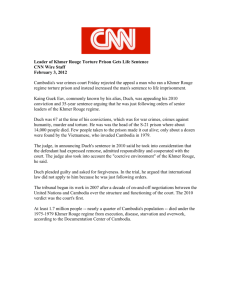
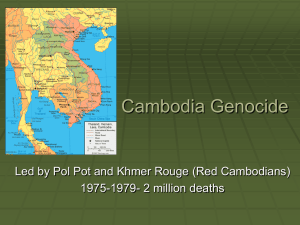
![Cambodian New Year - Rotha Chao [[.efolio.]]](http://s2.studylib.net/store/data/005298862_1-07ad9f61287c09b0b20401422ff2087a-300x300.png)
